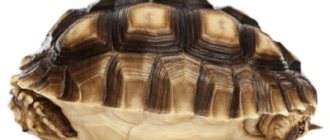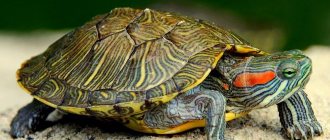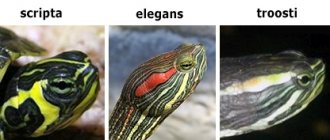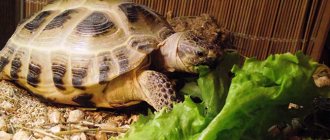It happens that you get a pet, look after it, take care of it, and at some point it gets sick or simply loses its appetite. This can easily happen to a red-eared turtle, which can be very finicky in its care. Of course, she won’t say why she doesn’t want to eat, but it’s quite possible to watch her and try to figure out what’s wrong yourself. And you should not hesitate with this in order to take timely measures and avoid complications.
Causes of loss of appetite
There are many things you should pay attention to to help your turtle feel the joy of life again. Some of the possible reasons that could deprive the mammal of calm:
- Getting used to a new environment;
- Adaptation in captivity;
- Disease;
- Stress;
- Intestinal problems;
- Extreme temperatures (cold or hot);
- Puberty;
- Poor nutrition.
The main reasons for the reluctance to eat are considered to be stress from a change in habitat and hypothermia of the animal. From the transportation process itself, the reptile’s nervous system can be severely damaged and it will take more than one day to recover.
Possible reasons
There are several reasons why a red-eared turtle may lose its appetite and not eat anything at all for several days:
- Feed is given too often . This is typical for inexperienced owners. In most cases, not everyone can know the nutritional norm for a given type of reptile. Adults eat food once every two days and are able to control their own needs when replenishing energy;
- The onset of hibernation . As a rule, this results in a sharp decrease in the activity of all reptiles. If the red-eared turtle stops eating at this particular time, then it is quite possible that he is about to fall asleep;
- Mature turtles may enter breeding season. This causes a sharp change in the behavior of the animal. True, this option is possible if two individuals of different sexes are kept together;
- The turtle got sick. As a rule, animals that feel unwell refuse to eat, become lethargic , and are constantly sleepy.
Only an attentive and experienced owner can determine the correct reason for a pet’s refusal to feed, therefore, it is recommended to use the help of specialists from veterinary clinics.
Solution
After carefully observing your pet and, unfortunately, not finding out the true reasons for his starvation, the best solution would be to make every effort to create comfortable conditions for your turtle. The following instructions will help:
- To begin with, take care of a fairly large turtle “house” - an aquaterrarium, the volume of which should be about 200 liters. The container should only be filled halfway.
- Usual conditions. Care must be taken to ensure that the turtle feels at home, where it spends most of its time not in the water, but on land. To do this, you need to equip a small island in the middle made of high-quality plexiglass with recesses that will provide the turtle with convenience and comfort when diving onto it. A bedding made of moss, sand, algae or other material that will not make the water cloudy is also suitable. It is important to take into account that the pebbles should not be small, otherwise the lover of absorbing everything in her path may become very ill.
- Water purity. The fluid must be changed at least once a week, and preferably when it becomes dirty. The water will be of high quality and suitable for your red-eared beauty if you first settle it and pass it through a filter.
- Amount of water. Only 30 cm of liquid is enough for the reptile to feel at home and be able to easily get out onto land.
- Suitable climate. To do this, you need to maintain the water temperature in the aquarium starting from +26⁰С and make sure that it does not rise above + 35⁰С. If the house is cold, heaters will help. The air temperature will also be suitable, and this is a couple of degrees more than that of water, if you use ultraviolet irradiators or incandescent lamps. These devices will provide air heating and will also help the patient fight rickets.
Mr. Tail explains: the reasons for the red-eared slider's refusal to eat
There are many reasons for this behavior. Here are just the main ones.
Dietary disorders
Some owners feed their pets incorrectly, which leads to indigestion and refusal to eat. In addition to nutritious food in original packaging, turtles should add chicken, fish, seafood, as well as fresh vegetables (carrots, zucchini, cabbage), fruits, and other plant foods (lettuce), gammarus.
If your pet refuses a particular product, it means she doesn’t like it and should be excluded from her diet. For example, young individuals often do not eat vegetables.
Turtles don't drink; they get liquid from their food, so they put it in water. Giving dry food can cause your reptile to become dehydrated.
Binge eating
It is important to know that young individuals are fed once a day, and adults - once every 2 days. If you give food more often, the turtle simply will not eat, and uneaten leftovers will float in the aquarium where it is kept. It is necessary to monitor your pet and develop a feeding regimen that is suitable for her.
Disease
Only a veterinarian will be able to determine whether the tortoise's lethargy is caused by illness or other factors. Therefore, if such a manifestation occurs and you refuse to eat, you should consult a specialist.
Incorrect content
It must be remembered that turtles are reptiles and, unlike mammals, cannot independently maintain their body temperature. It depends on environmental factors. So, if the water in the aquarium is too cool, the turtle becomes lethargic and inactive, tries to stay on the surface, and crawls out to bask on the rocks.
If this is the reason, it is worth placing a thermometer in the water and, if necessary, purchasing a water heating device, as well as a special lamp.
Stress
Red-eared turtles are very sensitive to sudden sounds and movements, and changes in environment. As a result of stress, they may refuse to eat. Once the irritating factor is eliminated, her condition will return to normal.
Overwintering
Often turtles try to hibernate in the autumn-winter period, even at home. It is better not to allow this, as this is fraught with the development of many diseases. For example, gout or liver failure. It can also lead to the death of the pet.
To prevent the turtle from hibernating, you need to follow a few simple rules: maintain a water temperature of +30 °C and strictly observe daylight hours, turning off the lighting fixture at night and turning it on in the morning.
Mating games
If there is a pair of turtles in the same aquarium, refusal to eat may be associated with the onset of mating season. At this time, the amount of food consumed is reduced, which is the norm. Upon completion of the mating games and mating process, the turtles will again return to their normal diet.
Problems with stool
If your pet is constipated, she refuses to eat. If there are no feces within several days, you should consult a veterinarian.
The stronger turtle suppresses the weaker one
Often this situation occurs when several males are kept together at the same time. The suppressed individual receives less food, and sometimes it gets nothing at all. This is dangerous for the health and life of the pet and it is better to place it in another aquarium.
Change of habitual habitat
When moving to another aquarium, turtles may stop eating. It is important to stick to your usual diet, you just need to give it some time to get used to the new territory.
Getting into Captivity
After placing wild turtles in an aquarium or terrarium, they can refuse food for up to 7 days, then they get used to the new conditions and their diet returns to normal.
If this does not happen, you need to consult a specialist.
Diet of the red-eared slider
To avoid loss of appetite, you should not allow your pet to eat low-quality food. This will have a detrimental effect on her health and lead to serious illness. Several points relate to this:
- The presence of animal products in the diet (seafood, fish, liver, bird offal);
- Plant foods (apples, cabbage, spinach, carrots, lettuce, dandelion greens);
- Restriction in feeding with special food for turtles;
- Don't let her crawl around on the floor, where she might, as usual, ingest something and become infected with salmonella;
- Avoid monotony. Food should be very varied and nutritious.
If you have done everything possible to create suitable conditions for your pet, and, despite everything, she looks very weak, exhausted, lost weight, does not leave the water and sleeps a lot, then you need to urgently treat her. And not on your own, for example, using the Internet, but by contacting a turtle specialist - a herpetologist, who can professionally find out the reason behind the lack of appetite. Before that, try to pamper your turtle: feed it seaweed, because this is its most favorite treat! And who knows, he might suddenly be tempted and start eating?
Features of the red-eared turtle and causes of lethargy
These turtles are good for keeping at home, have good health, are active, smart, and individual. These pets are suitable for allergy sufferers. However, it is worth keeping in mind that reptiles as pets have certain characteristics and in order for them to feel good, it is important to create the necessary conditions for them. Lethargy and refusal to eat in a cold-blooded reptile is often due to the fact that the owner did not provide the correct diet, did not take into account the change of seasons, and was unable to create a terrarium as close as possible to natural conditions.
In the presence of an unfavorable environment and the inability to extract the necessary elements from food, the red-eared turtle may simply hibernate. Then its biorhythms will slow down, and the unfavorable stage will pass with less losses for the reptile’s body.
Is it dangerous
The situation becomes dangerous if the turtle gets sick. In other cases, appetite returns on its own.
Turtle owners are often concerned about what to do if the reason for the lack of appetite is not clear. In this case, the animal must be taken to a veterinary clinic and shown to a qualified specialist.
Usually, experienced turtle breeders themselves can correctly determine the cause of a pet’s lack of appetite. Beginners need to pay attention to the slightest deviations in the animal’s behavior and, at the first suspicion that the turtle is unwell, make an appointment with a veterinarian.
What to do?
The reason why the red-eared turtle has lost its appetite can be eliminated either independently or with the help of a veterinarian. It all depends on how serious the situation is.
If you feed frequently, you should reduce the amount and start giving as much food as the turtle can eat at one time. Leftover food is removed immediately , otherwise it may spoil, which will lead to illness if the turtle decides to finish it. Most often you can give vegetables and herbs. Adult turtles are mainly herbivores, so they are fed protein foods periodically.
When preparing a turtle for hibernation, you need to bring it out of this state. Reptiles of this species hibernate under certain conditions that are almost impossible to create at home. A turtle may fall asleep and never wake up, especially if for some reason it is weakened and exhausted.
In the aquaterrarium, you need to increase the water temperature to 28 degrees, make the lighting brighter and longer. Daylight hours should be increased by two or three hours.
When keeping male and female red-eared turtles in the same aquarium, you can observe their mating games. Upon completion of mating, the animals will begin to eat, so you should just wait, since nothing will be done in this case.
It should be noted that for female turtles of this species, sexual maturity occurs at the age of four years. Males are ready to reproduce at the age of five. Therefore, if the reptiles are younger, the reason for refusing to eat lies elsewhere.
It is advisable to determine the symptoms of a sick turtle . When there are no visible causes and the development of the disease has not been identified, it is advisable to consult a veterinarian. During the examination, possible causes of the disease will be identified, the correct treatment will be prescribed and the necessary manipulations will be carried out. In addition, the veterinary clinic will give the necessary recommendations for further care of the turtle. Very often, experts recommend taking special vitamin complexes for freshwater reptiles.
It is strictly forbidden to self-treat your pet . In most cases it will be incorrect and may make the turtle's condition even worse.
Why does the turtle lose its appetite and vigor?
Let's take a closer look at how long a red-eared turtle can live without water and what other reasons could be for its lethargy and loss of appetite.
It is extremely important to remember that your pet is physically dependent on a water source. Two days without water will lead to very sad consequences for a representative of this species. Moreover, the pet needs to regularly change its drink to a new one. That's why, if your red-eared slider is not eating, is lethargic and sleeps too long, make sure, first of all, that your pet is properly provided with clean water.
Other reasons for a pet’s unusual behavior include the following:
- acclimatization. She will do her job - and after a while the pet is again alert and has a healthy appetite;
- overfeeding the animal - too much feeding often leads to a complete refusal to eat;
- improper conditions of detention, in particular, non-compliance with temperature limits;
- dehydration, which is often caused by poor-quality food or insufficient moisture in the place where the animal is kept;
- closed eyes of a turtle may indicate inflammation of the eyelids;
- The mating season greatly affects reptiles if the aquarium contains individuals of different sexes. After sexual activity subsides, they will become the same.
- any diseases deprive the animal of vigor and healthy appetite.
Do red-eared turtles hibernate?
Under natural conditions, turtles need winter sleep; it helps them survive the cold and short sunny days. Inhabitants of fresh water bodies kept at home do not need hibernation. By maintaining the same temperature and degree of ultraviolet radiation, the pet will survive the autumn period and only slightly reduce activity. If there are no visible signs of illness, but the turtle is sleeping and not eating, then prepare to “overwinter” for one or two months.
The room for sleeping should be made small, at the bottom there should be a ten-centimeter layer of sand and a little water to create humidity. When you transplant your pet into a house, lower the temperature to 8–10 °C within a week and a half. Place the turtle on the veranda, balcony or take it to the basement. Check your pet regularly and carefully.
Remember: the domestic freshwater turtle does not need a long period of rest, so there is no need to specifically create conditions for hibernation.
How long can a turtle go without eating?
The pet has been refusing food for several days now, and it is unknown whether there will be a change in behavior in the near future. Many turtle owners observe this picture. It is quite natural that panic begins, because refusing food cannot be safe for the body for a long time. If we consider the question of how long a red-eared turtle can go without eating, then we are talking about a period of about three weeks. Some land species do not want to eat during the heat, when the thermometer is above 25°C. Fasting can last up to two to three months.
What to do if your red-eared slider won't eat
Lack of appetite should be eliminated only after the cause of this phenomenon has been established. If the turtle is hypothermic, you just need to raise the temperature a couple of degrees, and the animal will immediately revive and become active. Your appetite will return quickly.
If the turtle is not feeling well due to digestive problems, then you need to feed it light food. After some time, digestion will recover on its own.
There is no need to do anything during the mating period. When the hormones calm down, the turtle will begin to eat on its own.
If the turtle gets sick, refuses to eat and becomes lethargic, it needs to be shown to a veterinarian.











